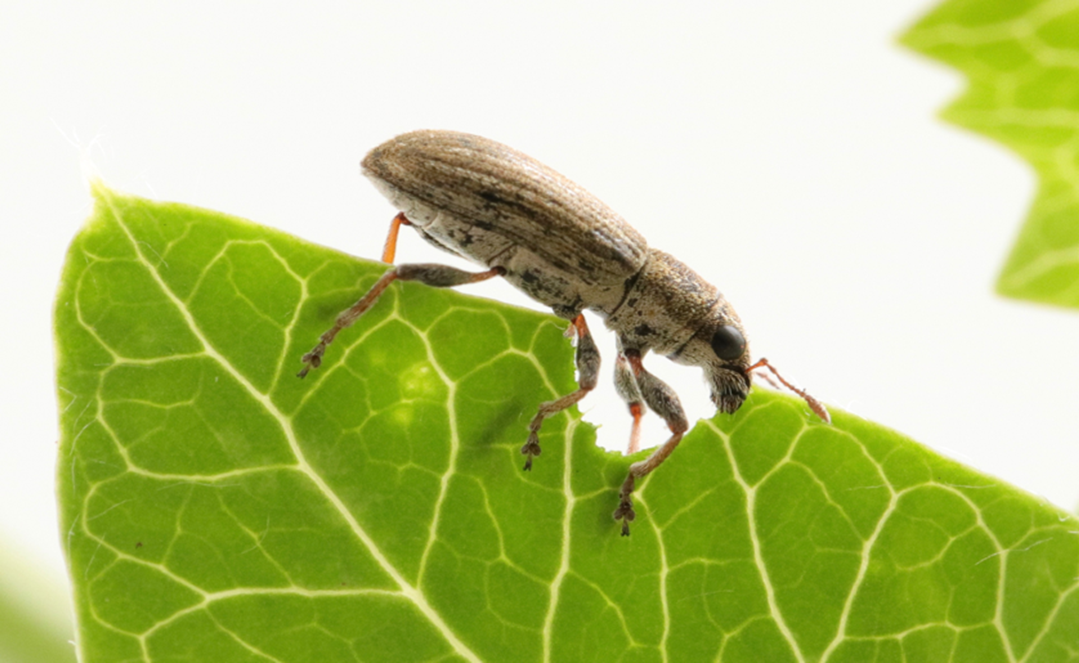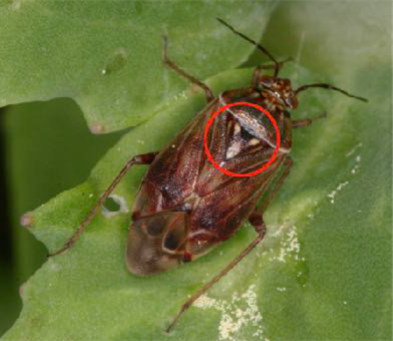Jennifer Bogdan, P.Ag., CCA
The pea aphid (Acyrthosiphon pisum (Harris)) is a common insect found wherever pulses are grown in Saskatchewan. Pea aphids cause damage to their host plants by sucking plant sap. They can reduce yield through
decreased seed formation and seed size. While pea aphids do overwinter in Saskatchewan, it is typically during years when high aphid numbers blow in on southerly winds from the United States that aphid damage can be a concern. Due to their unique life cycle, consisting of all females with the ability to produce all-female live young, pea aphids can reproduce at a fast rate, making them a pest to watch for in pulse crops.
Host Crops and Crop Injury
Peas, lentils, faba beans, chickpeas, dry beans, alfalfa, and clover are all host crops of pea aphids. Soybeans are not a suitable host crop for pea aphids, but they are a host crop for the soybean aphid (Aphis glycines).
Research from Agriculture and Agri-Food Canada (AAFC) (unpublished) has found that pea aphids will choose peas and lentils over faba beans initially, but as pea and lentil crops dry down, winged aphid populations can colonize faba bean crops in high numbers. Faba bean fields should be checked for pea aphids once surrounding pea and lentil crop senescence has begun.
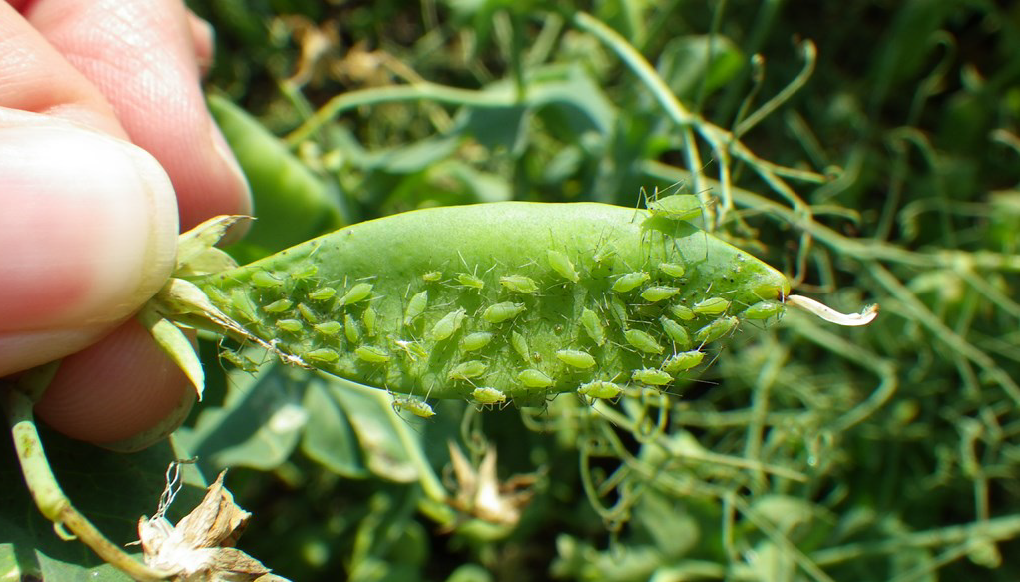
Source: Jennifer Bogdan
Aphids feed on the growing points of plants (where the plant is moving its sugars to), resulting in a drain of nutrients to the plant. Leaves, petioles, stems, flowers, and young pods are all fed on by adult and nymph stages of the pea aphid (Figure 1). Aphids use their mouthparts to pierce plant tissue and suck plant juices. Yield loss, due to reduced seed formation and seed size, primarily results from feeding on the flowers and early pods. Research has shown that even very high numbers of aphids feeding on peas during the vegetative stage has no effect on growth or yield. Peas are also able to compensate for, or recover from, aphid feeding on leaves and stems. The protein content of peas is not impacted by aphid feeding.
Besides direct damage from feeding, aphids can also transmit viruses such as the Pea Seed-Borne Mosaic Virus which can damage the plants further.
Identification and Life Cycle
Adult pea aphids are 3 to 4 millimetres (mm) long with soft, pear-shaped bodies that are light to dark green in colour. They have long legs and a pair of long, slender cornicles (tail pipes) protruding from the abdomen (Figure 2). Cornicles are hollow tubes that secrete a liquid containing alarm pheromone which warns other aphids when a predator is nearby. Adults may be winged or wingless (Figures 3 and 4). Nymphs look similar to adults, only smaller in size and wingless. Both nymph and adult aphids walk slowly across plant surfaces.
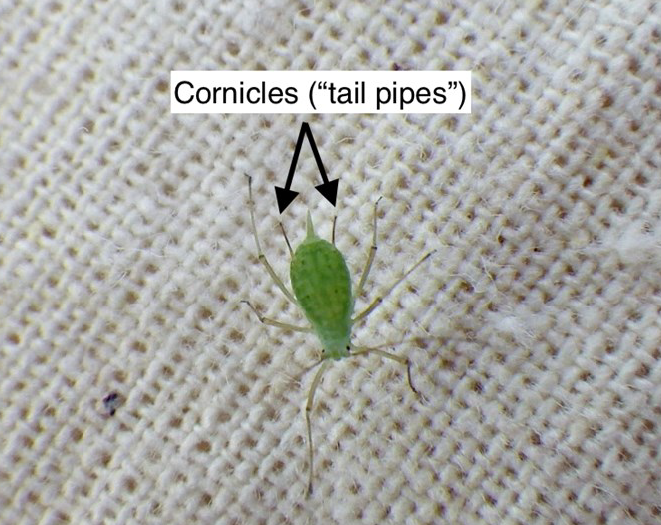
Source: Jennifer Bogdan
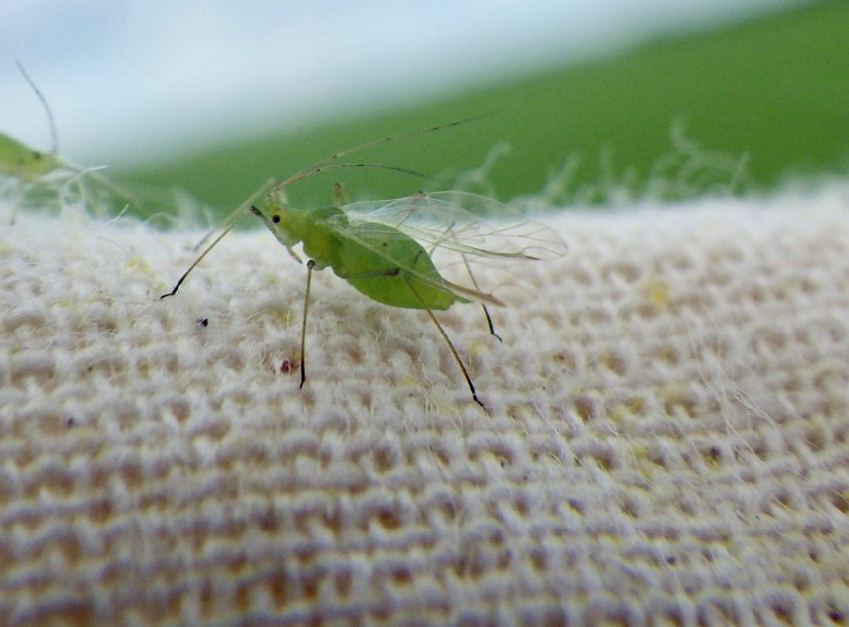
Source: Jennifer Bogdan
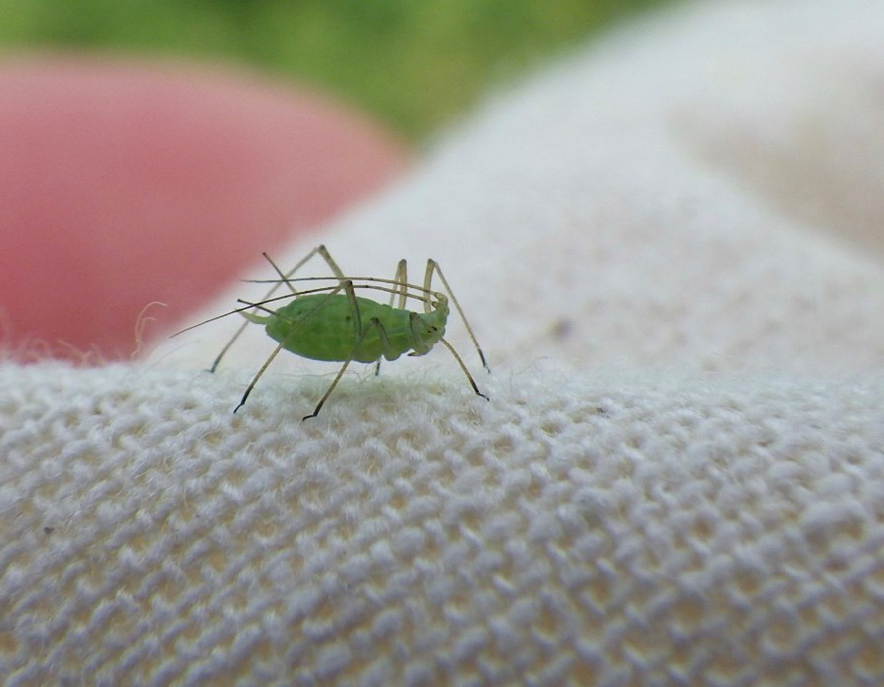
Source: Jennifer Bogdan
Pea aphids overwinter as eggs on perennial legumes such as alfalfa and clover. When plant growth resumes in the spring, the eggs hatch into small, wingless female nymphs. Once full-grown, these females, called stem mothers, can reproduce without mating and will give live-birth to the next all-female aphid generation. In the second and third generations, both winged and wingless aphids are produced and the winged aphids can migrate into other host crops such as peas and lentils. These winged aphids feed, then produce a generation of wingless females, which in turn produce a generation of winged and wingless females. Whenever a host crop becomes less suitable for aphid
development, such as when the crop is cut or begins to senesce, the winged aphids will fly to new host plants to live on. This cycle continues until late summer or early fall when winged females fly back to their overwintering host crops and produce winged males and wingless females. They mate and the females lay eggs on the leaves and stems of perennial legumes. The eggs can withstand the low temperatures that kill nymphs and adults.
Pea aphids can produce seven to 15 generations per year. Aphids typically take seven to 12 days to develop from birth to adults, or longer
depending on the weather. The optimum temperature for aphid development is 23 to 28°C. During the summer, a single female can produce 50 to 150 young (four to 12 young per day), attributing to a fast population growth.
Scouting and Economic Thresholds
Scouting: Begin scouting in pea and lentil crops when 50 to 75 per cent of the plants are flowering. At five well-spaced locations in the field, take five 180° sweeps or check at least five 8 inch (in) or 20 centimeter (cm) plant tips. Average the aphid counts for the field to calculate aphids per plant tip or sweep.
Research from U of S found that pea aphids arrived on faba bean plants around the early flowering stage, which is typically one calendar week later than lentils. Scout fields often is imporant as can take less than one week for aphid populations to go from 280 aphids per plant to 800 aphids per plant. Furthermore, pea aphid populations may migrate from pea and lentil fields due to maturity differences between crops with faba bean remaining longer than pea or lentil. Monitoring frequently from end of July to mid-August is essential for preventing crop losses due to pea aphids.
| Crop | Economic Threshold |
| Lentil | 29-43 aphids per 180° sweep |
| Pea | 2-3 aphids per 8 inch plant tip, or 9-12 aphids per 180° sweep |
| Faba | 34-50 aphids per main branch |
Threshold for Pea
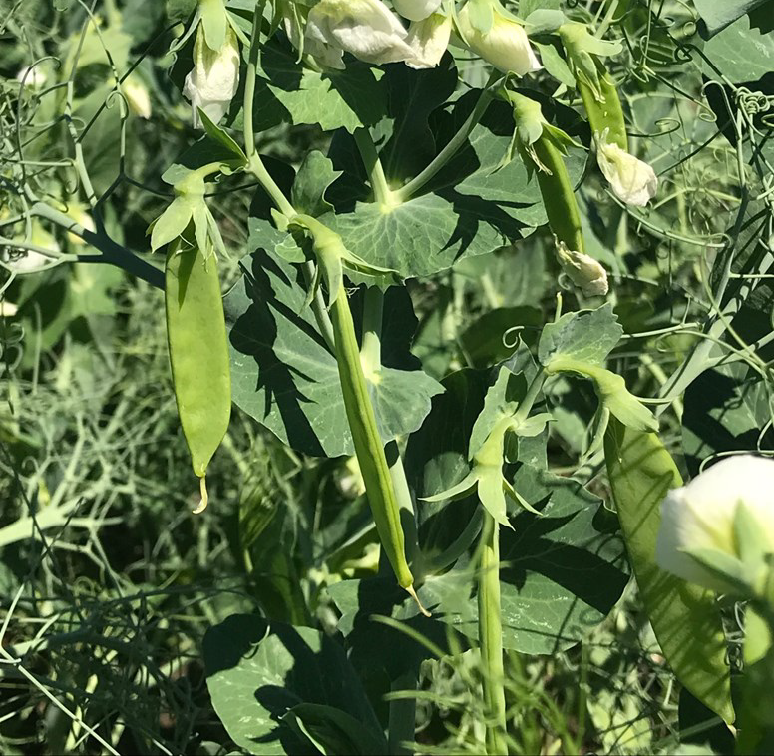
Source: Melanie Leppa, Soils & Such Agronomy
The only economic threshold that has been developed for pea aphid in pulse crops in Western Canada is in peas. This research was conducted from 1981 to 1983 at AAFC Winnipeg, using the variety Century, a large-seeded yellow pea variety registered in 1960. The economic threshold is two to three aphids per 8 in (20 cm) plant tip, or nine to 12 aphids per sweep, based on the price of peas at $5.71 per bushel, and the cost of control at $6.73 to $9.25 per acre. Newer varieties may be able to tolerate more feeding, especially under good growing conditions such as adequate moisture. The threshold is based on aphids per plant tip, but there are likely aphids lower in the plant as well. Table 1 correlates aphids counts and yield loss in peas.
If an insecticide treatment is deemed necessary, a single application when 50 per cent of the plants have young pods should be sufficient to protect the crop through the early pod stage, which is the most
sensitive to feeding damage. At this stage, the crop will be in late flower and the seed pods will still be fairly flat (Figure 5). Aphids can recolonize a sprayed field, and numbers can increase to levels as high or higher than what was originally present, within two weeks of the application. Spraying too early leaves the young pods susceptible to recolonization, while spraying too late (after most pods have formed) subjects the early pods to injury, since damage to these pods can occur in as little as four days of feeding.
Table 1. Yield Loss in Peas for Average Aphid Counts
| Aphids per Sweep | Aphids per Tip | Per Cent Yield Loss |
|---|---|---|
| 7 | 1 | 3.4 |
| 10 | 2 | 4.9 |
| 12 | 3 | 6.1 |
| 15 | 4 | 7.1 |
| 16 | 5 | 8.0 |
| 18 | 6 | 8.8 |
| 20 | 7 | 9.6 |
| 21 | 8 | 10.3 |
Per sweep or per 8 in tip of a pea stem when approximately 25 per cent of the crop has begun to flower.
Source: G.Maiteki and R. Lamb, AAFC Winnipeg, 1985 as summarized by John Gavloski, Manitoba Agriculture, 2017
Threshold for Lentil
A nominal threshold for pea aphids in lentils has been adopted from North Dakota and contains three qualifiers: 1) 30 to 40 aphids per 180° sweep, 2) few natural enemies are present, and 3)aphid numbers do not decline over a two day period.
Recent research from the University of Saskatchewan confirmed that the nominal threshold matched the economic threshold (29-43 aphids per 180° sweep). This work also indicates that the economic threshold for spray intervention provided approximately seven days of lead time before aphid populations to rise enough (64 to 92 per sweep) to cause yield loss (economic injury level).
Threshold for Faba Bean
Faba bean can be quite susceptible to pea aphid infestation, but until recently, there was no economic threshold for faba bean in Saskatchewan. Research to understand yield loss from pea aphids in faba bean and the optimal spray timing was conducted at the University of Saskatchewan (Ningxing Zhou et al, 2022). Results found that pea aphid populations double more quickly on faba bean compared to lentil and established the economic threshold of 34-50 aphids per main branch of faba bean plant. This economic threshold provides a seven-day lead time time before pea aphid populations are expected to exceed the economic injury level of 96-142 aphids per main faba bean branch.

Source: Ningxing Zhou, University of Saskatchewan
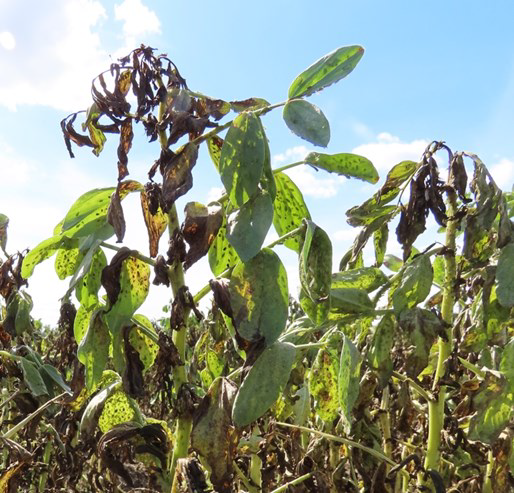
Source: Ningxing Zhou, University of Saskatchewan
Threshold for Chickpea and Dry Bean
Chickpea and Dry Bean are not a preferred host of pea aphids. While they may occasionally become infested with pea aphids no economic threshold has been established for these crops.
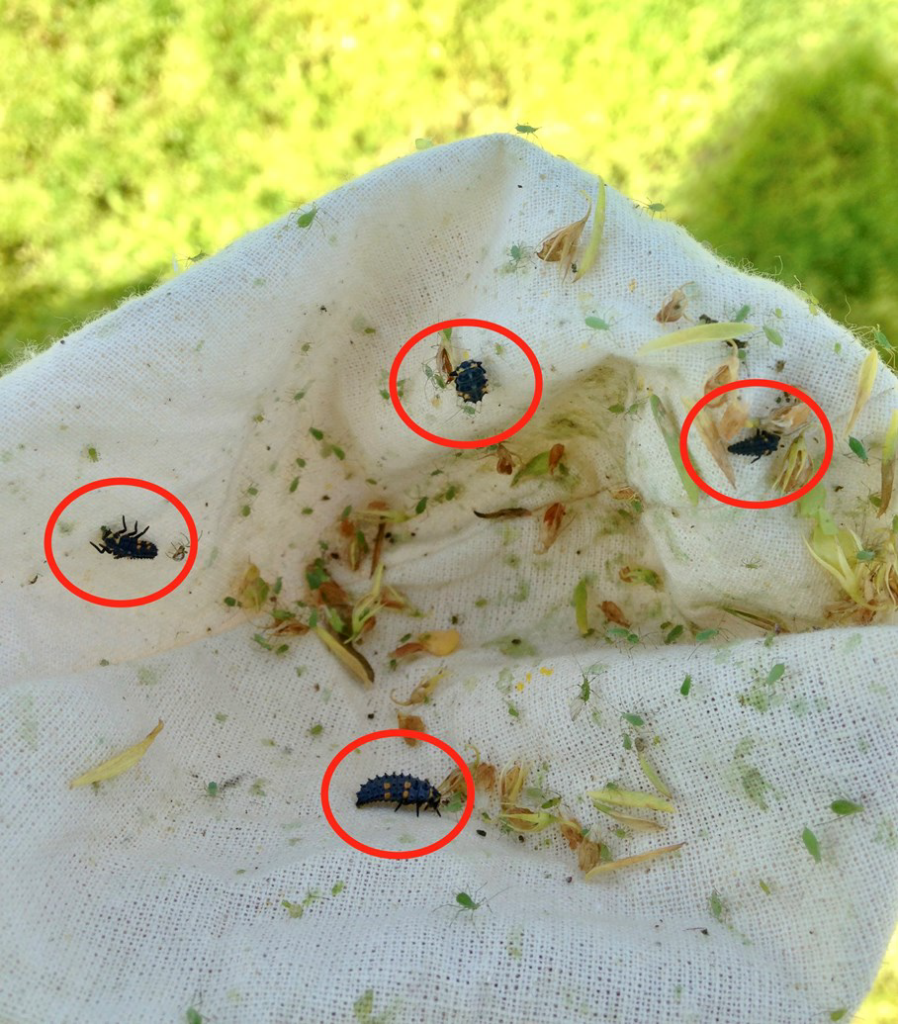
Source: Jennifer Bogdan
Important Considerations For a Decision to Spray
- Aphids are very sensitive to physical disturbance because of their soft bodies. A heavy rain or severe wind can dislodge aphids from the plants and reduce the population in the crop. Regular scouting is essential to track changes in aphid numbers.
- Even though the flowers and early pods are most sensitive to aphid feeding, if there is sufficient moisture, plants are able to
compensate for some of their fluid loss. Aphids will have more of a negative impact on a crop under moisture stress. - Beneficial insects can play a major role in controlling aphid populations. Always scout for, and consider the presence and density of beneficial insects before deciding to spray and insecticide. Unnecessary insecticide applications are devastating to beneficial insect populations (Figure 8).
- Since aphids feed on plant sap, once seed filling is complete and the crop is no longer lush and actively growing, a winged generation of aphids will appear and migrate to other greener crops. Aphids will not cause economic damage to crops that have completed seed filling.
Management
Cultural Control: Early seeding may help the crop avoid high aphid populations during the flowering and early pod stages. Establishing a uniform and competitive plant stand can promote the crop to develop more evenly through the growth stages making scouting, and spraying (if required), for aphids easier. Since pulse crops are large-seeded and the seed weight of individual varieties can vary greatly, using the
thousand kernel weight calculation to determine a proper seeding rate is essential to achieve a desired crop density.
Biological Control: A number of insect predators will actively feed on aphids, including ladybeetles (adults and larvae), lacewings (primarily larvae), hoverflies or syrphid flies (larvae), minute pirate bugs (adults and nymphs), and damsel bugs (adults and nymphs) (Figures 9 to 16). These predators can have a substantial impact on keeping the aphid population below threshold levels. For example, seven-spotted
ladybeetle adults can eat 48 aphids per day, and their larvae can eat 71 to 72 aphids per day. Lacewing adults will lay eggs in unsprayed
vegetation around fields where prey populations develop. Lacewings will later migrate into nearby crops as aphid (or other prey) populations develop. Lacewing larvae inject a toxic saliva containing digestive
enzymes into their prey.
Parasitic wasps in the Aphidiidae family, such as Aphidius ervi, will also attack pea aphids. The female wasp lays a single egg inside of an aphid and the egg hatches into a larva which begins to consume the aphid from the inside out. When the larva pupates, the parasitized aphid swells up, turns tan in colour and the body becomes mummified. When the new adult wasp is ready to emerge, it chews a small round hole in the aphid mummy to exit, and then immediately begins laying eggs in other aphid hosts. Egg-to-adult takes two to four weeks within the host, and there may be three or more generations per year. Aphid colonies should be examined for aphid mummies to determine if parasitic wasps are present (Figures 17 and 18).
Chemical Control: Insecticide options can be found in the Saskatchewan Ministry of Agriculture’s Guide to Crop Protection. Be sure to check the label for the specific crops listed, as not all options are registered for use on all pulse crops. For example, dimethoate is registered on peas but not on lentils. Some products are systemic within the plant and may provide longer residual control than contact insecticides.
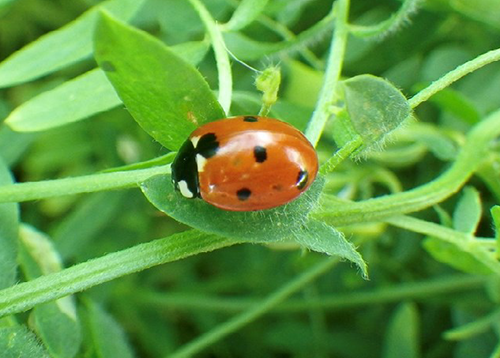
Source: Jennifer Bogdan
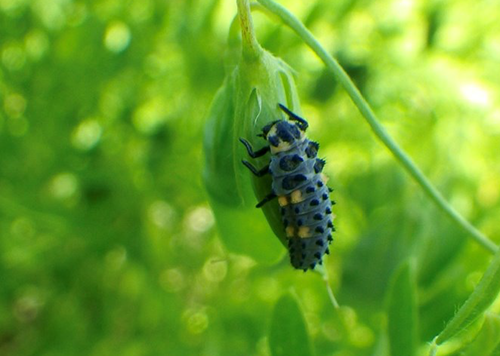
Source: Jennifer Bogdan
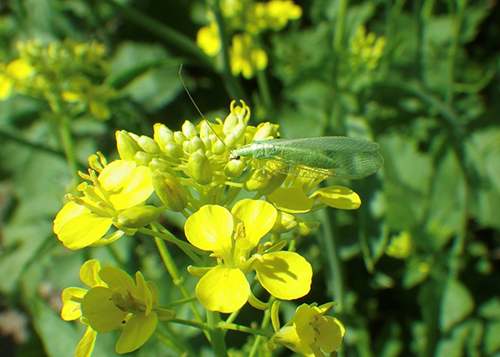
Source: Jennifer Bogdan
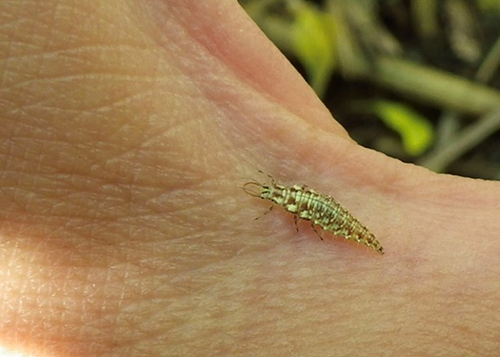
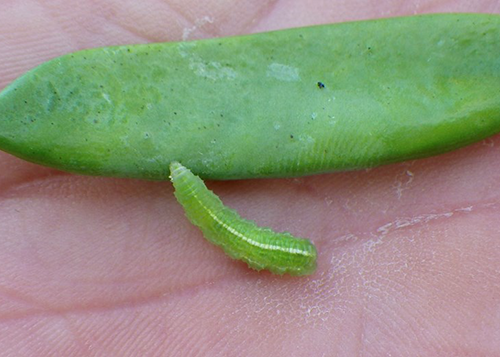
Source: Jennifer Bogdan
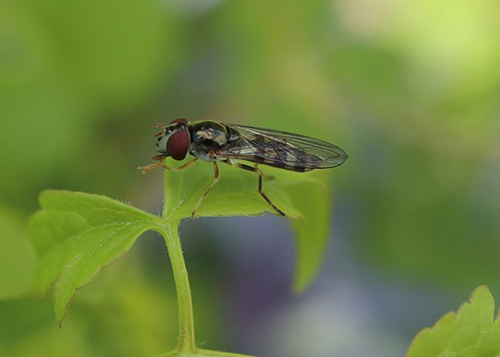
Source: Jennifer Bogdan
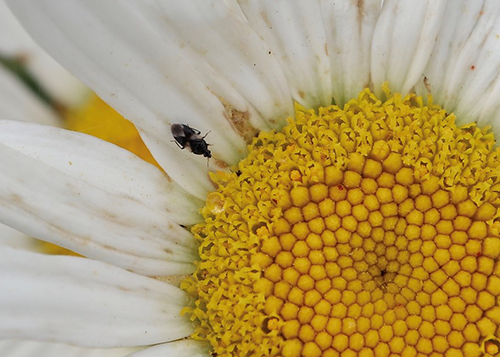
Source: Jennifer Bogdan
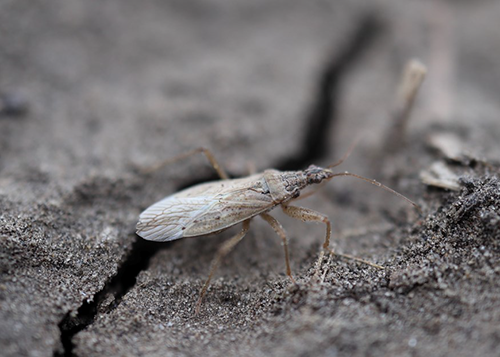
Source: Jennifer Bogdan
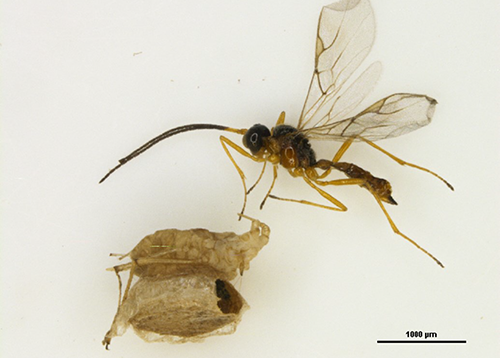
Source: Tyler Wist, AAFC
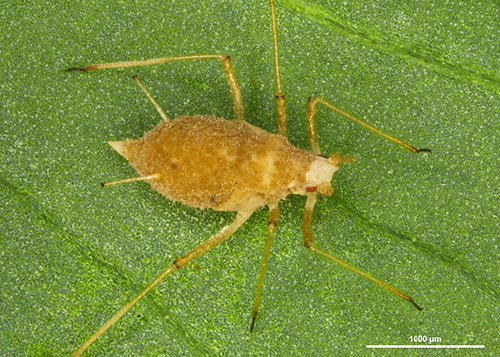
Source: Tyler Wist, AAFC

